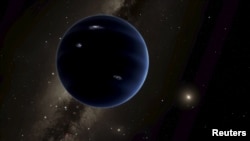Scientists are pretty sure Planet Nine is out there, they just can't figure out how it got to the outer reaches of our solar system.
That's the perplexing conclusion of some new research by astronomers at the Harvard-Smithsonian Center for Astrophysics (CfA).
"The evidence points to Planet Nine existing," says Gongjie Li, a CfA astronomer and lead author on the new research. "...but we can't explain for certain how it was produced."
Long journey
The existence of Planet Nine has been the stuff of myth and mystery for years.
For conspiracy theorists, it has long been the mythical planet Nibiru that winds its way to earth every 10,000 years or so, leaving destruction in its wake.
That ridiculousness aside, scientists have long been noticing odd things about the movements of a few extrasolar bodies way out beyond Neptune.
These little planetoids are called dwarf planets, because they are much smaller than Earth. Pluto - the former ninth planet in our solar system before it was 'demoted' from planetary status - is one, then there's Eris, and Makemake, and a host of others.
But it was the movements of two planetoids in particular, Sedna and 2012 VP that caught the eye of some Caltech scientists.
In January, Mike Brown and Konstantin Batygin published research that crunched the numbers and pretty definitively proved that there is something very big, much bigger than Earth out there, tossing around all the little guys.
They named it Planet Nine. It has about 10 times the mass of Earth, and its year is measured between 10 and 20,000 years.
OK it's there! But how?
Since then, scientists have been working to learn more about this super Earth, and they're not getting any definitive answers.
In this new report, astronomers reportedly ran millions of computer simulations to test one way that such a large planet ended up in the outskirts of our solar system. That scenario involves a star that moved close enough to our sun to pull Planet Nine out into its orbit. The math says there's only a 10 percent chance of that happening.
Li's new research was just accepted for publication in the Astrophysical Journal Letters.
But that's not the end of the story!
Some of Li's colleagues have already submitted two complementary papers to the Astrophysical Journal.
Their work presents two other likely scenarios: one is that Planet Nine formed in the same neighborhood as our other big guys, Jupiter and Saturn, and that a series of gravitational tugs bullied it out of the region.
The other possibility is that Planet Nine actually formed as it was, way out in the hinterlands.
It's a mystery that astronomers are excited to solve.
"The nice thing about these scenarios is that they're observationally testable," CfA astronomer and author Scott Kenyon points out. "A scattered gas giant will look like a cold Neptune, while a planet that formed in place will resemble a giant Pluto with no gas."
Stay tuned.









